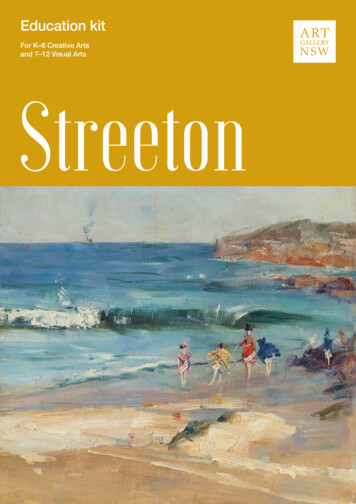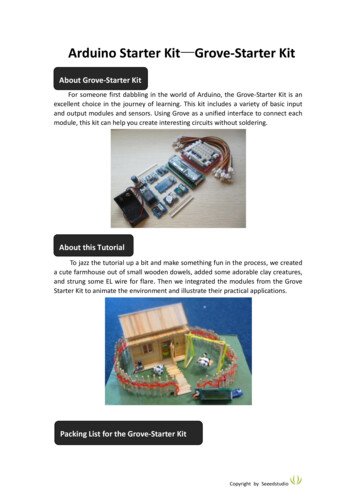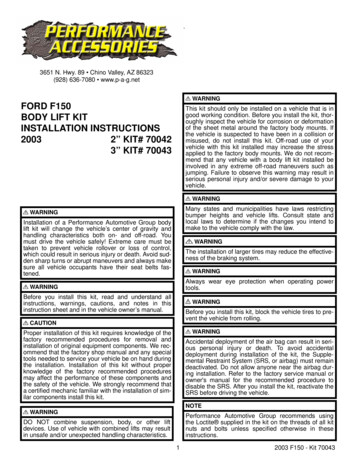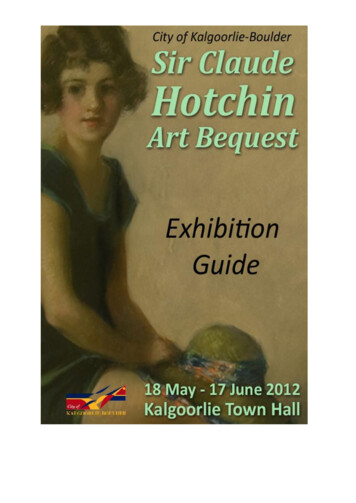
Transcription
Education kitFor K–6 Creative Artsand 7–12 Visual Arts1 Streeton Art Gallery of New South Wales Education Kit
ContentsIntroducing Arthur Streeton. 3Unpacking the exhibition: themes. 5The new paintingAn artist’s city: Streeton in SydneyStreeton overseasThe big picture: national landscapesThe artist as environmental activistFocus works. 15The national game 1889Still glides the stream, and shall for ever glide 1890Fire’s on 1891Villers-Bretonneux 1918Credits. 23Cover image: Arthur Streeton Beach scene 1890,Art Gallery of New South Wales, Sydney, purchasedfrom the Estate of Henrietta Tuson 19542 Streeton Art Gallery of New South Wales Education Kit
IntroducingArthur Streeton‘I just go on with my work, believing in myself that’s all’.In the late 19th and early 20th centuries Arthur Streeton came to be regarded in Australiaas its most significant landscape artist. Streeton’s naturalistic impressionism offered a newway to visually experience the light, atmosphere, colour and forms of our natural world.His exceptional abilities as a painter meant he adapted his mark-making to purpose, usingthe matter of paint with verve to capture a vital sense of place. Streeton’s youthful talentand fresh vision are a given, but he was also a sensitive and deeply romantic bohemianwho eventually became one of the most commercially successful and popular establishmentartists of his generation. His character was complex and even contradictory: he was byturns provocative and conservative, an individualist and yet immersed in close friendships.He remained throughout his own man and valued his drive as an artist. As he wrote in 1918to a patron who was critical of his recent paintings, ‘I just go on with my work, believingin myself that’s all’.1The new paintingStreeton embraced plein-air oil painting in the 1880s, following the international influenceexerted by the Barbizon school of painters in France and the radical artists known asthe impressionists. By the end of the decade, Streeton’s vivid paintings of Melbourne,nearby coastal scenes and rural landscapes at Box Hill and Heidelberg, generated bothadmiration and criticism. Supporters saw a fresh and true vision of Australia deliveredin a contemporary way, while detractors viewed his improvisatory brushwork as wilfullyuntutored and incomplete. The Art Gallery of New South Wales helped resolve the debateover whether Australian impressionism had a future when it purchased Streeton’s wideformat Heidelberg landscape Still glides the stream, and shall for ever glide 1890 fromthe young artist in 1890.2Streeton in Sydney1 Arthur Streeton letter to WalterBaldwin Spencer, 11 Oct 1918,in Ann Galbally & Anne Gray (eds),Letters from Smike: the letters of ArthurStreeton 1890–1943, Oxford UniversityPress, Melbourne, 1989, p 151.2 The Art Gallery of New South Waleshad already purchased CharlesConder’s impressionist paintingDeparture of the Orient – Circular Quay1888 in 1888, but the Streeton waspurchased after The 9 by 5 impressionexhibition in 1889 had broughtdebates in Australia for and againstimpressionism to a head.3 Arthur Streeton letter to TheodoreFink, early Apr 1890, in Galbally &Gray, p 17.On the strength of this support for the new art movement, Streeton came to Sydney andlater stayed in the artists’ camp at Little Sirius Cove just across the harbour from the city.Streeton was transfixed by Sydney, the light and warmth, the waterways and beaches,describing it in a letter as ‘a land of passion-fruit & poetry’.3 He immediately set to workcapturing the scenes before him, developing his soon-to-be-famous blue in differing shadesfor ocean, harbour and skies. He was further buoyed by the Gallery’s purchase in 1893of his great painting of summer heat, industry and incident, Fire’s on 1891. His Australianlandscapes from this period culminated in his magnificent elevated vistas of the HawkesburyRiver from 1896, including his perfectly realised exercise in receding space and brightsummer atmosphere, The purple noon’s transparent might 1896, purchased by the NationalGallery of Victoria in a hometown victory for Streeton. These works remain justly admiredand are an important part of our cultural identity, yet they are only part of Streeton’s prolificoutput over six decades.Streeton overseasIt is a measure of Streeton’s confidence and desire to both learn and challenge himself thathe joined the exodus of artists from around the world to the European art centres at the endof the 19th century. Streeton arrived in London in 1897 but found himself just another young3 Streeton Art Gallery of New South Wales Education Kit
IntroducingArthur Streetoncolonial striving for recognition in a highly competitive art scene. His hardest and hungriestyears followed. He was doggedly determined, and worked through the influence of JohnConstable, JMW Turner, James Abbott McNeill Whistler and contemporaries such as JohnSinger Sargent and Philip Wilson Steer in his practice. The resulting large-scale muscularlypainted landscapes are supreme examples of Edwardian English painting. These achievedsome success at the Royal Academy in London and the Paris Salons and even moresuccess when sent back to Australia. Streeton worked out a formula for return visitsto Melbourne and Sydney, producing new Australian subjects to be exhibited alongsideEuropean works. His developing good business sense meant he discerned an audiencewho wanted paintings of both home and away.The war yearsThe First World War interrupted Streeton’s growing London career and prevented his returnto Australia for several years. Too old to fight, he threw himself into working in a hospital forwounded soldiers before becoming an official war artist in France. His most poignant warpaintings pair the gentle beauty of the French landscape with quiet scenes of desolation.Streeton returned to Australia soon after the end of the war, coming home to a saddenedbut optimistic country. His big view pastoral landscapes in the 1920s, such as Land of theGolden Fleece 1926, painted in three versions, captured the public’s imagination as imagesof promise and plenitude gained from Australia’s human endeavour and abundant naturalresources. The conservative cultural commentary that grew up around these paintings cannow seem uncomfortably nationalistic, though these views were not repeated by Streetonin his own frequent public writing.The big picture: national landscapesThere is an absence and a presence in all of Streeton’s Australian landscapes. Aboriginalpeople are never depicted and yet they are present as Streeton paints land cared for byAboriginal custodians over millennia.4 This becomes more evident when he began travellingbeyond the outskirts of Melbourne, painting areas that are less altered by European farmingpractices. Streeton’s vistas encompass mountains, forests and plains shaped by Aboriginalland management, including landscapes managed by fire and landscapes left to grow, withpatchworks of grasslands and bush belts that pre-date European settlement. SometimesAboriginal presence becomes even more obvious when Streeton paints ancient spreadinggums that have grown in open grasslands shaped by fire regimes. From our point in time,absence can be replaced with overwhelming evidence of other lives lived in this landscapewhen Country is read from Indigenous perspectives.5The artist as environmental activist4 Streeton rarely included any figuresin his landscapes after returning toAustralia in the early 1920s.5 Listening to traditional custodiansor reading books on Aboriginal historyand land management, such as BrucePascoe’s Dark emu, Magabala Books,Broome, 2014 or Bill Gammage’sThe biggest estate on Earth: howAborigines made Australia, Allen &Unwin, 2012, reveals ways of seeing amuch richer, ancient and layered historyin the places that Streeton painted.Streeton’s carefully self-managed career and consistent sales from 1907 onwards inAustralia resulted in homes in Toorak in Melbourne and Olinda in the Dandenong Ranges.Acceptance by the establishment mattered to him later in life, and his public roles as anartist and a critic led to a knighthood from George VI in 1937. He was proud of what hehad achieved, but he also used his public platform as a respected person of arts andletters to condemn land clearing and environmental degradation. He published extensivelyfrom the late 1920s on conservation and urban planning issues, and exhibited paintings thatpredicted a desolate and barren future for Australia unless it changed its destructive ways.So many years on, the future he foretold for Australia seems to be coming true.Adapted from Wayne Tunnicliffe ‘Introducing Arthur Streeton’ in Streeton, Art Gallery of New South Wales, 20204 Streeton Art Gallery of New South Wales Education Kit
Unpacking the exhibition: themesThe new paintingClockwise, from top left:Arthur StreetonEarly summer – gorse in bloom 1888oil on canvas, 56.2 x 100.6 cmArt Gallery of South Australia,Adelaide, gift of Mrs AndrewTennant through the Art Gallery ofSouth Australia Foundation 1982Arthur StreetonAustralian December 1886oil on canvas, 39.9 x 65 cmNewcastle Region Art Gallery,gift of the Newcastle Region ArtGallery Foundation 1993Arthur StreetonEvening with bathers 1888oil on canvas, 40.8 x 76.4 cmNational Gallery of Victoria,Melbourne, bequest of SundayReed 1982Arthur StreetonWindy and wet c1889oil on cardboard, 14.3 x 24 cmNational Gallery of Victoria,Melbourne, purchased 19555 Streeton Art Gallery of New South Wales Education Kit
The new paintingInvestigateThe 1880s was an exciting time in Australianart. Plein-air painting – painting outdoors infront of the subject – was embraced and anew style developed that was aligned withart practices in Europe, the United Kingdomand the United States. A desire for changeconverged with cosmopolitan influencesthat led away from the carefully detailedstudio painting of more conservative artists.The younger painters adopted a freer stylebased on direct observation, experimentingwith heightened colour and evidentbrushstrokes, and focused on the life andlandscapes around them. Distinctively localand demonstrably international, it becameknown as Australian impressionism. ArthurStreeton turned 13 in 1880. He began hisart education early in the decade and byits end he was one of the leaders of thenew painting movement that deliveredits manifesto in The 9 by 5 impressionexhibition in August 1889.The now legendary exhibition was carefullystaged by the key instigators Streeton,Tom Roberts and Charles Conder in August1889. The ‘9 by 5’ in the title refers to thedimensions of the cigar box lids that someworks were painted on, which determinedthe scale of most exhibits.Critic James Smith, decried the paintings’lack of ‘finish’, likening their ‘slap-dashbrush work’ to ‘primeval chaos’. The9 by 5 paintings were closer to the tonalpanels exhibited by James Abbott McNeillWhistler in London in 1884, where Robertsis thought to have seen them, than thevivid colour and broken brushwork ofthe French impressionists.6 Streeton Art Gallery of New South Wales Education KitImagine walking through Early summer –gorse in bloom 1888. List the local featuresdepicted. Now imagine walking throughWindy and wet c1889. How is your journeydifferent? Write a letter to a friend describingyour experience of each place.Imagine flying over one of these landscapesand describe how the colours make youfeel. What are the sounds, smells andtextures you imagine there to be?How does plein-air painting offer theaudience a greater sense of the landscape?CreateIn The 9 by 5 impression exhibition, ‘9 by 5’refers to the dimensions of the artworks.What is the impact of this small scale andusing the same dimensions across multiplepaintings? Discuss how the impact wouldchange if the artworks were larger in scale.Create an artwork where scale plays asignificant role in its impact.ReflectHow was Streeton’s art radical andavant-garde for its time? How did this newapproach to painting shape 20th-centuryart practices? What are the benefits ofthe plein-air approach to painting?
An artist’s city:Streeton in SydneyClockwise, from top left:Arthur StreetonThe purple noon’s transparentmight 1896oil on canvas, 123 x 123 cmNational Gallery of Victoria,Melbourne, purchased 1896Arthur StreetonBeach scene 1890oil on canvas board, 39.6 x 29.5 cmArt Gallery of New South Wales,Sydney, purchased from the Estateof Henrietta Tuson 1954Arthur StreetonThe railway station, Redfern 1893oil on canvas, 40.8 x 61 cmArt Gallery of New South Wales,Sydney, gift of Lady Denison 1942Arthur StreetonFireman’s funeral,George Street 1894oil on canvas, 45.3 x 38.2 cmArt Gallery of New South Wales,Sydney, purchased 19807 Streeton Art Gallery of New South Wales Education Kit
An artist’s city:Streeton in SydneyInvestigateStreeton first visited Sydney in June 1890after the sale of Still glides the stream,and shall for ever glide to the Art Galleryof New South Wales earlier in the year.He became entranced with the harbourand beaches and particularly with thechanging effect of light on water duringthe course of a day and in differing weatherconditions. Streeton supercharged thecolours he had used previously for bushsubjects near Melbourne, creating saturatedtones including the rich ultramarine thatbecame known as ‘Streeton blue’.On his second visit in 1891, Streetonenthused in a letter to a Melbourne friend‘Sydney is an artist’s city – glorious .a land of passion-fruit and poetry’.Choose one of these paintings and describethe colours used. Why do you think Streetonselected them? List some words to describethe brushstrokes. Can you see details,or has the scene been simplified? Howdoes Streeton show movement? Why doyou think Streeton was interested in thechanging effect of light on water and indiffering weather conditions?CreateWhat do you love about the place whereyou live? Create an artwork entitled‘A land of passion-fruit and poetry’ usingsupercharged colours and ‘Streeton blue’.ReflectFrom 1892 Streeton lived at the CurlewCamp on the harbourside at Mosman,on Cammeraigal and Borogegal land.His bold use of colour and experimentswith format and cropping during thistime encapsulated the energy of late19th-century Sydney. In 1896 he heldStreeton’s Sydney sunshine exhibitionin Melbourne, which was a resoundingsuccess, and in 1900 The Bulletinasserted that Streeton was the‘discoverer of Sydney Harbour’.Etched in the landscapes where Streetonpainted – along Bradleys Head, around theharbour coves and headlands as well asfrom Sydney’s coastal clifftops – are myriadartistic engravings that assert the prior andenduring occupation of the IndigenousGadigal people of the Eora Nation.To utter traditional names of the placeswhere Streeton painted is to pause andconsider a more complex story than thatof his artistic invention of place. Long beforeMosman was named after the operatorof a local whaling station, and Little SiriusCove was named after the flagship ofBritish invasion, the area around MosmanBay was known as Gorma Bullagong byCammeraigal and Borogegal peoples.Cremorne was Wulwarrajeung. Coogeewas Koojah, an important and abundantfishing site of the Bidjigal people beforewhite occupation led to depleted stocks.Select one of these paintings and constructa story based on what you see. Describe themood that Streeton has created.8 Streeton Art Gallery of New South Wales Education KitHow has Streeton captured differingexperiences of place in these paintings?How do they relate to a contemporaryexperience of place?
Streeton overseasClockwise, from top left:Arthur StreetonThe centre of the Empire 1902oil on canvas, 122.5 x 122.5 cmPrivate collection, SydneyArthur StreetonFatima Habiba 1897oil on canvas on cardboard,29 x 27.4 cmArt Gallery of South Australia,Adelaide, gift of Douglas andBarbara Mullins through theArt Gallery of South AustraliaFoundation 1997Arthur StreetonBoulogne 1918oil on canvas, 91.8 x 153 cmArt Gallery of New South Wales,Sydney, gift of the artist 1926Arthur StreetonSanta Maria della Salute (grey) 1908oil on canvas, 51 x 76.5 cmGeelong Art Gallery, gift of TSHawkes 19149 Streeton Art Gallery of New South Wales Education Kit
Streeton overseasInvestigateBy the end of 1896 Streeton was regardedas one of Australia’s leading landscapepainters. While his paintings were stilloccasionally described as French in style,Streeton rejected this when interviewedin November 1896, claiming that hiswork ‘is purely and absolutely Australian,not only as regards colour, but in ideaand expression’.Despite strongly identifying as an Australianartist, Streeton joined the exodus of histalented peers to the art centres of Europe.He departed Sydney in January 1897,travelling to London via Cairo and Naples.In 1898 seven of his paintings wereexhibited in a large survey of contemporaryAustralian art at the Grafton Galleriesorganised by the Art Gallery of New SouthWales. Interest in his Australian paintingssuggested Streeton would soon establishhimself in London, but he becameoverwhelmed by the competitive Londonart scene, and his confidence faltered beingaway from his friends and the scenes ofhis early successes.His hardest and hungriest years followed.Yet he found motivation in the famous artfrom past and present that surrounded him,and in painting a new landscape and light,and doggedly worked through the influenceof John Constable, JMW Turner, JamesAbbott McNeill Whistler and contemporariessuch as John Singer Sargent and PhilipWilson Steer. The resulting large-scale,muscular landscapes are supremeexamples of Edwardian English painting.10 Streeton Art Gallery of New South Wales Education KitFind examples by John Constable, JMWTurner, James Whistler, John Singer Sargentand Philip Wilson Steer. Where can you seeinfluence from these artists on Streeton’s artpractice?What do these artworks tell us aboutStreeton’s experience in other countries.How do they compare to his paintings of theAustralian landscape?CreateCreate an artwork inspired by a place youhave visited or lived before. How is thisplace unique compared to where you livetoday? Think carefully about the colours,textures and forms you include. How dothey add meaning to your work?ReflectResearch Australian artists from the 20thand 21st centuries who have beencompelled to work overseas, includingArthur Streeton. Why do some artists feel itnecessary to work outside of Australia?How does this journey impact their artmaking?Compare Australian and Frenchimpressionist art. How did the artists of theimpressionist movement offer uniqueperspectives of the places they lived?
The big picture:national landscapesClockwise, from top left:Arthur StreetonLand of the Golden Fleece 1926oil on canvas, 92.3 x 146 cmPrivate collection, SydneyArthur StreetonOur untidy bush 1934oil on canvas, 76.6 x 64 cmNational Gallery of Victoria,Melbourne, Felton Bequest 1934Arthur StreetonThe valley from Olinda top‘Let the rose glow intenseand warm the air’ – Keats 1925oil on canvas, 63.8 x 101.6 cmNational Gallery of Victoria,Melbourne, Felton Bequest 1925Arthur StreetonThe creek 1925oil on canvas, 51 x 77 cmArt Gallery of New South Wales,Sydney, Edward Stinson BequestFund 200411 Streeton Art Gallery of New South Wales Education Kit
The big picture:national landscapesInvestigateStreeton’s pre-eminent place in Australianlandscape painting was secured in the firstdecades of the 20th century. During andafter the First World War, discussions ofAustralian impressionism evolved fromrepresenting a national school of art toembodying an ideal of nationhood itself.In 1919 critic and artist Lionel Lindsay wroteof The purple noon’s transparent might:‘It is a great portrait of our birth place, andblazons high the claim of Arthur Streetonto the status of a great national painter’.Streeton brought his Somme battlefieldscenes to Australia in 1920 and exhibitedthem alongside Australian paintings fromthe previous decades, sensing our evolvingidentity was closely linked to the fighting inEurope. With the death of 60 000 Australiansoldiers and with another 15000 Australiansdying during the Spanish flu pandemicin 1919, it is little wonder audiences alsoresponded to the familiar pastoral scenesof Streeton’s new Australian works, paintedin a style they now trusted. Streeton’s1920s landscapes were widely celebratedand occasionally criticised for beingconservative or glibly painted. While theyare not modernist, they participated inthe making of a modern Australia shapedby both progressive and traditionalcultural values.There is an absence and a presence in all ofStreeton’s Australian landscapes. Aboriginalpeople are never depicted and yet they arepresent as Streeton paints land cared forby Aboriginal custodians over millennia.12 Streeton Art Gallery of New South Wales Education KitWhat do you notice about these landscapeswhen viewed from a distance and closeup? Reading these landscapes froman Indigenous perspective, can you seeevidence of other lives lived here?Consider the management of the landand the presence of grasslands andgum trees.CreateCreate an abstract interpretation of aStreeton landscape. Reflect on Streeton’suse of scale, composition and painthandling. Use these ideas in your work.Compare your work to the originalStreeton painting.ReflectAnalyse the ideas being communicatedin these paintings? Research why thischoice of subject matter was importantafter the impact of the First World War.Do you think this vision of an idealisedagricultural life was correct at the time?How do you think these paintings havecontributed to the development of anAustralian identity today?
The artist asenvironmental activistClockwise, from top left:Arthur StreetonBeneath the peaks,Grampians 1920–21oil on canvas, 63.5 x 76.1 cmArt Gallery of New South Wales,Sydney,purchased 1920 andcompleted in 1921Arthur StreetonLast of the messmates 1928oil on canvas, 62.5 x 75 cmPrivate collection, SydneyArthur StreetonA mountain side 1935oil on canvas, 86.5 x 111.5 cmWestpac Corporate ArtCollection, SydneyArthur StreetonSilvan Dam and Donna Buang,AD 2000 1940oil on canvas, 75 x 62cmPrivate colleciton, Hope Island, Qld13 Streeton Art Gallery of New South Wales Education Kit
The artist asenvironmental activistInvestigateStreeton believed that artists shouldparticipate in public life and that theiropinions mattered. He did not hesitate toexpress his own ideas on a wide varietyof topics and was often published in themajor newspapers of the day. Acceptanceby the establishment mattered to him laterin life, and his roles as an artist and culturalcommentator lead to a knighthood fromKing George VI in 1937. He was proud ofwhat he had achieved, but he also usedhis public platform to campaign on issueshe felt were significant.Locate Sherbrooke Forest and Olinda ona map and look at satellite photos. Findout about the climate and vegetation ofthis region. Notice the colours and patternsof this country. Compare the images withStreeton’s painting The vanishing forest1934.Streeton’s life-long love of nature led tohis speaking out against the destructionof Australia’s old-growth forests from themid 1920s. He was equally concernedabout urban planning, and in 1925campaigned to prevent a tramline beingbuilt through Melbourne’s Botanic Gardens.He titled a drawing of the gardens Bewareof the axe. From the late 1920s Streetonexhibited many paintings which sought tobring attention to the logging of old-growthforests and predicted a desolate future forAustralia if deforestation continued. It isremarkable that almost a century on weare still having the same debates.CreateSilvan Dam and Donna Buang, AD 2000 isa painting of Streeton’s vision of the year2000. How close was the prediction of hisfuture? Think about the year 2100. How doyou perceive Australia to be in 80 years?What is an important environmental issueto you? Produce a variety of sketches andphotographs based on your observationsof a landscape that is important to you. Usethese to create an artwork that responds tothe state of world we live in today.ReflectStreeton believed that artists shouldparticipate in public life and that theiropinions mattered. Do you agree with thisstatement? What is the role of an artist?Research Streeton’s contributions toenvironmental activism. Compare Streetonto contemporary artists who respond toenvironmental issues today. How can artplay a role in environmental conversations?14 Streeton Art Gallery of New South Wales Education Kit
Focus worksThe national game 1889Arthur StreetonThe national game 1889oil on cardboard, 11.8 x 22.9 cmArt Gallery of New South Wales,Sydney, purchased 1963An effect is only momentary . it has beenthe object of the artists to render faithfully,and thus obtain first records of effectswidely differing, and often of veryfleeting character’– The 9 by 5 impression exhibitioncatalogue, 1889These small paintings were first hung onthe walls of a Melbourne art gallery in1889, alongside similar works by Streeton’scontemporaries. Little did the artistsknow this would become one of the mostlegendary exhibitions in Australia’s history.The 9 by 5 impression exhibition wasorganised by Streeton and his friends TomRoberts and Charles Conder. Its namesimply came from the size of the pictures(they were all roughly 9 by 5 inches) and theidea that they were ‘impressions’, mostlyof the Australian landscape – waterfronts,country lanes, city streets, manicured parks,even a football field.15 Streeton Art Gallery of New South Wales Education KitIn these works, details are described inthe briefest of brushstrokes. And thosebrushstrokes are visible – thick and textured,or thin and brushy – sometimes lettingthe surface peek through. This outragedconservative critics, who dismissed themas mere sketches, unfinished and unfit forexhibition.But the artists were proclaiming that theirsmall landscapes – painted outdoors tocapture the effects of light and atmosphere– were as valid as large-scale paintingsof high-brow subjects. In fact, they wereclaiming these quick impressions were morehonest to the artist’s perception of place. Indoing so, they aligned themselves with theinternational impressionist art movement.
Focus worksThe national game 1889Early Stage 1–3Stage 4–6EngageInvestigateDescribe the colours, subject andcomposition of these paintings. How dothey represent Australia?What is the difference between a sketch anda finished artwork? The 9 by 5 impressionexhibition included paintings that wouldnormally have been considered preliminarysketches. How do these artworks differ fromtraditional painting at the time?CreateAs a class, create a group of landscapepaintings inspired by the environment ofyour school. Choose from both natural andman-made environments. Use the sameartwork dimensions and materials, and workin the plein-air technique to capture differentscenes. Write a citation or label for yourwork. Exhibit your artworks and invite othersto the opening.ReflectFind out about the era Streeton lived in.How was Australia changing? How was thattime in history similar and different to today?16 Streeton Art Gallery of New South Wales Education KitCreateCreate an artwork with the briefest ofbrushstrokes. How does this add newmeaning to the artwork?ReflectThe 9 by 5 impression exhibition wasstaged by Arthur Streeton, Tom Robertsand Charles Condor. Streeton was 22 yearsold and the only one among them born inAustralia. He represented a new generationof artists with no first-hand experienceof Europe or England. How would thisimpact his painting practice? What were hisambitions and that of his contemporaries?
Focus worksStill glides the stream,and shall for ever glide 1890Arthur StreetonStill glides the stream, and shallfor ever glide 1890oil on canvas, later mountedon hardboard, 82.6 x 153 cmArt Gallery of New South Wales,Sydney, purchased 1890I see what was, and is, and will abide;Still glides the Stream, and shall for ever glideThe Form remains; the function never dies– William Wordsworth’s sonnet of 1820on the River Duddon.In this early landscape, Streeton takesin a view of Victoria’s Yarra River flats fromthe hillside of Eaglemont near Heidelberg –lands of the Wurundjeri people. Today,Eaglemont is a residential suburb ofMelbourne, but in Streeton’s time it wasa country town and the surrounding richfloodplains were an important source ofVictoria’s produce. In the summer of 1890,Streeton, Charles Conder and Tom Robertscamped at the Eaglemont Homestead,where they immersed themselves in natureand painted outdoors. Their distinctivepaintings of the region earned them thename the ‘Heidelberg school’.Streeton was only 22 when he made thiswork – and the Art Gallery of New SouthWales bought it right away. This markedthe launch of Streeton’s career and thebeginning of his Sydney story. It was alsoa serious sign of the art establishmentsupporting Australian impressionism.17 Streeton Art Gallery of New South Wales Education KitThe title of the work is Still glides thestream, and shall for ever glide, whichis a line from a William Wordsworthpoem. Streeton was a poetry lover and,like Wordsworth and the Romantics, herecognised the enduring power of art.The stream at Eaglemont may no longerlook like this, but it ‘glides forever’ herein Streeton’s majestic painting.Still glides the stream is persistent inanother way, too – the painting has hungon the Gallery’s walls continuously sinceit was purchased almost in 1890.
Focus worksStill glides the stream,and shall for ever glide 1890Early Stage 1–3Stage 4–6EngageInvestigateFollow the line of the meandering stream.What do you see along the way? Whatsounds, textures and movement do younotice? Note the layers of colours andforms.
oil on canvas, 39.9 x 65 cm . Newcastle Region Art Gallery, gift of the Newcastle Region Art . Gallery Foundation 1993 Arthur Streeton . Evening with bathers . 1888 . oil on canvas, 40.8 x 76.4 cm . National Gallery of Victoria, Melbourne, bequest of Sunday . Reed 1982 Arthur Streeton . Windy and wet . c1889 . oil on cardboard, 14.3 x 24 cm










